|
E.E. Canberra T.17
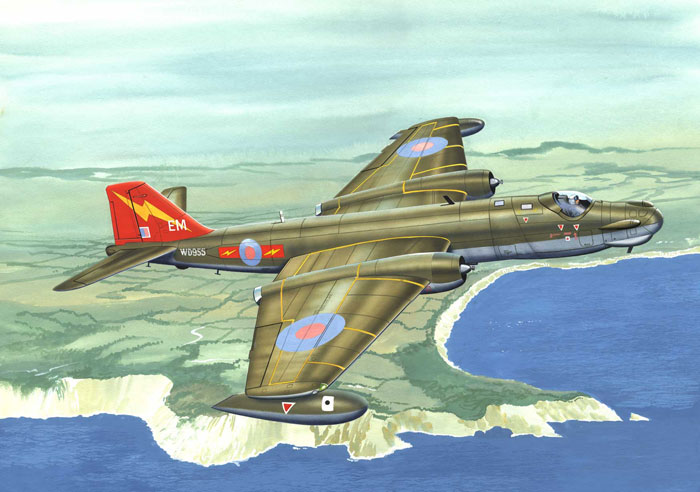
Classic Airframes, 1/48
scale
S
u m m a r y
|
| Catalogue Number: |
4129 - English Electric Canberra
T.17 |
| Scale: |
1/48 |
| Contents and Media: |
42 parts in grey styrene; 41 parts in grey colored
resin; 11 clear injection molded parts; instructions; decal sheet and
painting guide for two aircraft. |
| Price: |
MSRP
USD$60.00
Available online
now from Hannants for GBP£34.00 |
| Review Type: |
FirstLook |
| Advantages: |
First time available as an injection-moulded kit;
large and impressive; excellent surface detail including
crisply recessed panel lines, very high quality plastic moulding;
impressively detailed resin parts; generally very good fit; interesting marking choices. |
| Disadvantages: |
Some modelling experience helpful for preparing
resin parts; a little extra time required for alignment and perfect fit;
most resin parts loose in the bag. |
| Recommendation: |
Highly Recommended |
Reviewed by
Brett Green

Classic Airframes' 1/48 scale Canberra T.17 will be available online from Squadron
The English Electric Canberra was a groundbreaking
aircraft when it entered service in the early 1950s. The Canberra set
and held many altitude, distance and speed records in its early years.
In addition to widespread and long service with the Royal Air Force, the
English Electric Canberra was exported to many countries including
Australia, New Zealand, Sweden, France, West Germany, India, Pakistan,
Rhodesia, Ethiopia, Argentina, Chile, Ecuador, Peru and Venezuela.
The Canberra's service record was remarkable in its
longevity, spanning from the Suez crisis to Vietnam to the Persian Gulf.
In fact, the final Canberra PR.9s in RAF service are only due to retire
this year.
The Canberra T.17 was a specialised Electronic
Counter Measures/Electronic Warfare variant converted from the B.2
bomber. 22 of
these aircraft were produced specifically for a joint RAF/RN unit, 360 Sqn.
The bomb bay and the newly designed nose housed the additional ECM/ECW
equipment. The Canberra T.17 had retired from service by the mid-1990s.
Classic Airframes' 1/48 scale Canberra T.17 kit
shares much in common with the earlier B.2 and TT.18 releases, but
includes the unique nose and an additional 20 resin parts. The complete
kit comprises 42 parts in grey styrene; 41 parts in grey colored resin;
11 clear injection molded parts; instructions; plus a decal sheet and painting guide for
two aircraft.
Plastic parts are presented to a very high standard.
Moulding quality is excellent, and the highly polished finish does not
reveal any moulding imperfections on the exterior surfaces. Panel lines are crisply recessed,
consistent and very fine.
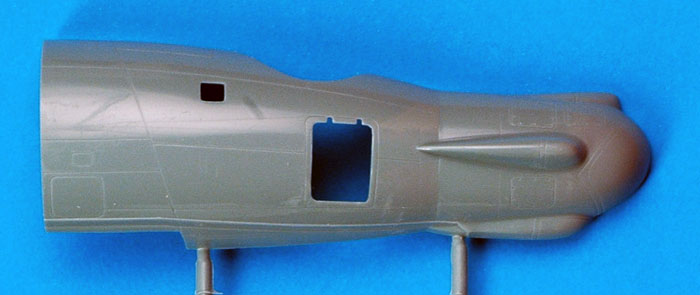
Click
the thumbnails below to view larger images:
The long fuselage is split into two halves for the main section and
another two for the nose. The slab-like wings
are supplied in two halves (upper and lower) each.
Although there are no locating pins on the main parts, the wings are reinforced with
two plastic spars spar. This will add rigidity
and ensure the correct dihedral. There are a few tall ejector pins on
the inside surfaces of the wings that should be sliced off prior to
assembly, but the remaining scars will not be visible after assembly.
The inner lip of the intakes also have ejector pin marks. These need a
bit more time and care in cleaning up.
Resin parts are very nicely detailed. The bulk of these details are
for the cockpit, including two gorgeous Martin-Baker ejection seats, but
the undercarriage bays, wheels and intake fans / starter bullets are
also supplied in resin.
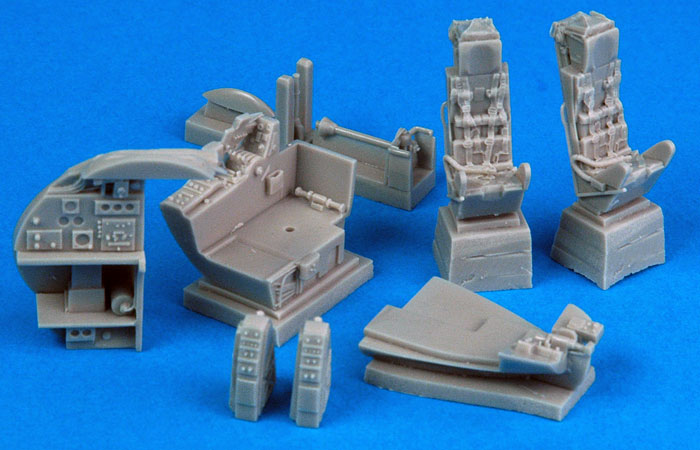
The front wheels are cast with mudguards on top of the tyres. Not all
Canberras were fitted with these mudguards, so check your references
before assembly. If your subject was not equipped with mudguards it will
be a simple matter to sand them off before painting.
The gear bays are immaculately detailed with structural features and
wiring. It is just a shame that so little of this detail will be seen
under the low-slung Canberra airframe.
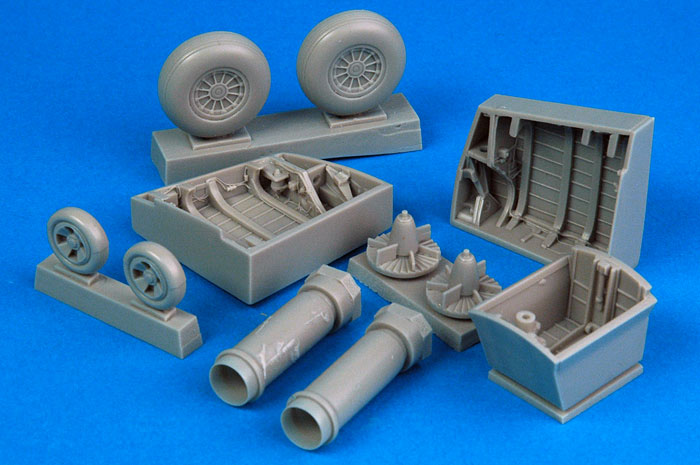
A new selection of resin parts includes the various external aerials,
attachment points, intakes and vents - plus a new tail cone -
appropriate for this ECM trainer variant.
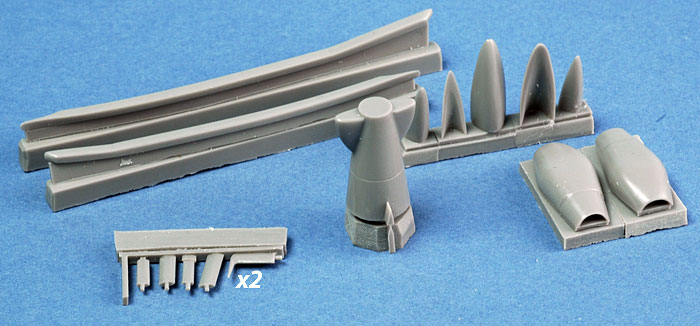
Some of the parts are cast onto stout blocks so a combination of a
good razor saw and caution will be required when preparing these resin
components.
Clear parts are well moulded and relatively distortion free - quite
an accomplishment considering the fishbowl configuration of the canopy!
The nose cone parts are not used for this variant. The clear parts do respond very
well to a bath of Future floor polish.
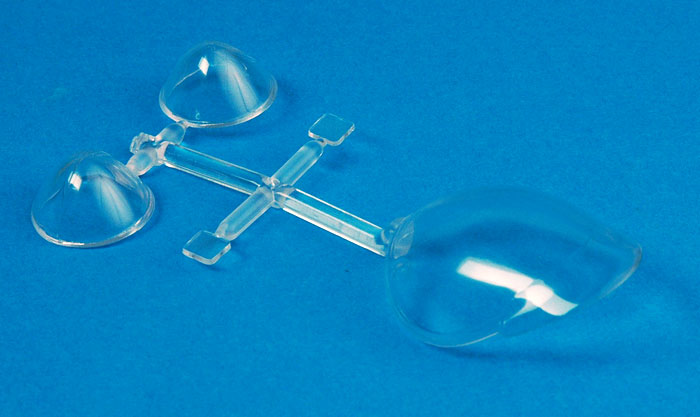
The shape of the model looks accurate compared to published plans and
contemporary photographs.
One of the challenges when building the Canberra B.2 kit was getting enough
weight in the nose to prevent the model sitting on its tail. This should not be a problem with the T.17, as the big new nose
section can be literally filled with lead much further forward from the
model's centre of gravity.
Markings
Two marking options are offered on the instructions:
-
Canberra T.17A, 360 Squadron RAF
Cottlesmore, late 1970s, finished in Dark Green, Dark Sea Grey and
Light Aircraft Grey
-
Canberra T.17A, 360 Squadron RAF
Wyton, November 1991, finished in the later scheme of Hemp and Light
Aircraft Grey with a red tail and yellow lightning bolt.
Click the thumbnails below to view larger images:
Decals are printed in perfect register, and colours look good.
Classic Airframes' 1/48 scale Canberra is a big, impressively
detailed, accurately shaped kit. With a recommended price of USD$60.00,
it is a bargain too, especially considering the extensive resin
included.
The relatively small parts count reflects the simple design of the
airframe, but does not compromise detail. It certainly does speed
construction though!
Granted, this model will need a little more cleanup
and preparation of parts than a long-run release from Tamiya or Hasegawa.
Also, the lack of locating pins will call for extra care and
dry-fitting. In other words, modelling skills are required, but
anyone who has already built a Classic Airframes kit should not have any
trouble coming up with a great result straight from the box.
I have already built Classic Airframes' 1/48 scale Canberra B.2 and can
confirm that fit is generally very good. You can
follow
this link to see construction comments and progress photos. With a little extra
time spent on preparation and alignment, it was a real pleasure to work on.
Highly Recommended to experienced modellers.
Thanks to
Classic Airframes for
the review sample.
Classic Airframes
kits are available worldwide through hobby retailers and from
Squadron.com
Review and Images Copyright © 2006 by
Brett Green
Page Created 08 September, 2006
Last updated 21 February, 2007
Back to HyperScale Main Page
Back to Reviews Page
|
Home | What's
New | Features
| Gallery |
Reviews | Reference
| Forum
| Search